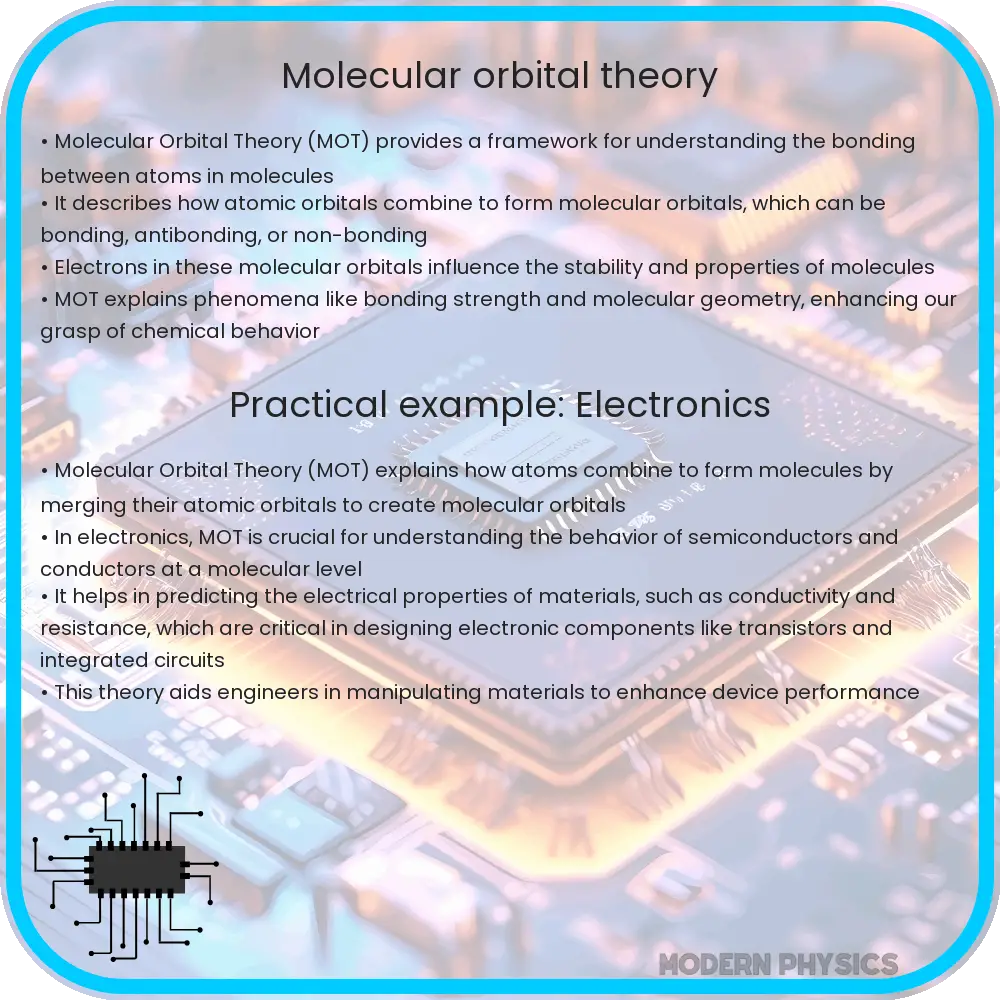Molecular Orbital Theory (MOT) explains electron distribution, molecule shapes, and chemical behaviors by studying overlapping atomic orbitals.

Molecular Orbital Theory: An Introduction
Molecular Orbital Theory (MOT) is a fundamental concept in chemical bonding that extends beyond the simple ideas of single-atom electron orbitals by describing how electrons are distributed in a molecule. At its core, MOT helps explain why molecules exist in nature, what shapes they take, and how they behave in chemical reactions. Understanding the energy levels, bonding, and symmetry in molecular orbitals provides a deeper insight into the electronic structure of molecules.
Formation of Molecular Orbitals
When atoms combine to form a molecule, their atomic orbitals (the regions in space where electrons are most likely to be found) overlap to form molecular orbitals. These new orbitals belong to the molecule as a whole. This concept is crucial because it suggests that in a molecule, electrons are not confined to a single atom but are shared between atoms.
The creation of molecular orbitals can be conceptualized by the Linear Combination of Atomic Orbitals (LCAO) method. According to LCAO, any molecular orbital \( \psi \) can be represented as a linear combination of atomic orbitals \( \phi \).
\[ \psi = c_1\phi_1 + c_2\phi_2 + … + c_n\phi_n \]
where \( c \) represents the coefficients that indicate the contribution of each atomic orbital to the molecular orbital.
Types of Molecular Orbitals
There are primarily two types of molecular orbitals that can form when atomic orbitals overlap:
- Bonding Molecular Orbitals: These are formed by the constructive interference between atomic orbitals, resulting in increased electron density between the nuclei of bonded atoms. Such orbitals are lower in energy than the original atomic orbitals because they help stabilize the molecule.
- Antibonding Molecular Orbitals: In contrast, antibonding orbitals are formed by the destructive interference of atomic orbitals. This leads to a node between the nuclei, where electron density is significantly lower, making these orbitals higher in energy and less stable.
Energy Levels and Molecular Stability
When we compare the energy of molecular orbitals, we typically find that:
- Bonding orbitals are lower in energy due to the stabilization resulting from the concentration of electron density between atomic nuclei.
- Antibonding orbitals are higher in energy because they contain nodes that correspond to regions of zero electron density between the nuclei, leading to a destabilizing effect.
The relative energy levels of these molecular orbitals affect the overall stability of the molecule. A stable molecule generally has more electrons in bonding orbitals than in antibonding orbitals. This principle is often quantified using bond order calculations, which also consider the number of bonding and antibonding electrons.
Application of Molecular Orbital Theory
Molecular Orbital Theory is not just theoretical; it plays a critical role in the practical understanding of chemical properties and reactions. For example, MOT provides insights into the color properties of compounds and the mechanisms in photosynthesis. In medicine, it helps explain how drugs interact at the molecular level, impacting their absorption and efficacy.
Furthermore, this theory aids in the development of new materials with desired electronic properties, crucial for electronic and photonic technologies. Thus, engineers and scientists frequently apply MOT to design better catalysts, more efficient energy storage materials, and more effective pharmaceuticals.
Conclusion
Molecular Orbital Theory (MOT) is a cornerstone of modern chemistry and materials science, providing deep insights into the behavior of electrons in molecules. By extending the understanding of atomic orbitals into the more complex interactions within molecules, MOT allows us to predict and explain the electronic structure and properties of new compounds. The theory’s applications range from the creation of new materials to the pharmaceutical industry, highlighting its importance in both academic research and industrial innovation.
Overall, MOT enriches our understanding of the molecular world, proving indispensable for students, researchers, and engineers alike. As we continue to discover the vast potential of materials and chemical processes, Molecular Orbital Theory remains a key tool in shaping the future of science and technology.
